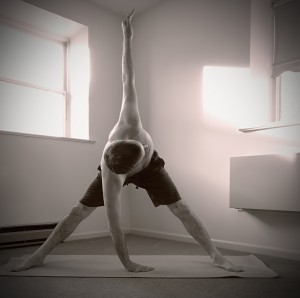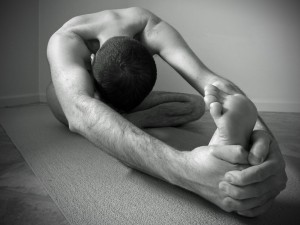Ready to sweat it out in the yoga room? A new study examines the safety of hot yoga, and finds that doing yoga in a heated environment may not be that much different from less extreme styles.
The moment you open the door to the yoga room, already packed wall-to-wall with brightly colored sticky mats, the heat in the room—not to mention the oppressive humidity—hits you like a wave and knocks you backwards.
And while you stand blocking the doorway, with your hand on the slick metal handle and one foot still outside basking in the last cool air you’ll feel for the next 90 minutes, you consider bailing on the class altogether.
It would be easy to do—to slink back to the changing room before anyone notices … anyone except that super-slender woman behind you in the tiny stretch yoga shorts and bikini top who’s giving you a stern look as you teeter on the edge between crisp, cool air conditioning and the blast furnace that people refer to as hot yoga.
In fact, you only signed up for this class because your friends told you how amazing it is. “It’s a great way to detoxify,” they said. “You’ll lose weight and, best of all, you’ll feel great!” Right now, though, the heat beating you in the face makes you question their sanity even more.
But, to avoid facing your friends later without having stepped into the yoga room at all, you brace yourself against the heat and take the plunge. You set down your rented yoga mat in the only spot left—in the middle of the front row!—and remind yourself that if you can play soccer in the dead of summer, you can certainly survive a yoga class with a little heat added.
Unfortunately, “a little heat” hardly does hot yoga justice. These classes, which are hot in temperature and popularity, range from 90º F to a brain-scorching 105º F, with the humidity hovering near 40 percent during the entire 60 to 90 minutes of bending and stretching.
Hot Yoga for the (Varied) Masses
 Hot yoga is a broad term, with styles varying from studio to studio. Many people are familiar with Bikram Yoga, a form of hot yoga that uses the same 26 postures (along with two breathing exercises) in every 105º F class. But it’s not the only hot yoga out there. In some other classes, you’ll find yourself racing through a vigorous flow —moving quickly from pose to pose—in temperatures that start at 90º F or 95º F and, with all the added body heat, quickly shoot upwards.
Hot yoga is a broad term, with styles varying from studio to studio. Many people are familiar with Bikram Yoga, a form of hot yoga that uses the same 26 postures (along with two breathing exercises) in every 105º F class. But it’s not the only hot yoga out there. In some other classes, you’ll find yourself racing through a vigorous flow —moving quickly from pose to pose—in temperatures that start at 90º F or 95º F and, with all the added body heat, quickly shoot upwards.
Like everyone else who has ever signed up for a 30-day hot yoga challenge (a favorite marketing angle of Bikram studios everywhere), you are probably wondering if this style of extreme yoga is safe. Certainly, halfway through your first class, as sweat pours off your body and collects in a puddle (no, a vast salty lake) on your once-sticky mat, you may feel like you are about to die.
Critics of hot yoga are more than willing to back up your sense of impending doom, claiming that the excessive heat lulls people into pushing their bodies too far, putting them at risk of muscle damage from overstretching, as well as dehydration, heat exhaustion and heat stroke. In the worst-case scenario, dangerous increases in your core body temperature can be fatal.
Study Examines Safety of Hot Yoga
Until now, though, few scientific studies had looked at the safety of doing yoga in hot and humid environments. Researchers from the University of Wisconsin-La Crosse hope to change that by evaluating the body’s physiological response to hot yoga, specifically core body temperature and heart rate.
The new study, which appeared July 2013 in ACE ProSource, a publication of the American Council on Exercise, put 20 healthy males and females (between 19 and 44 years of age) through their hot yoga paces. About half of the participants had done hot yoga before. The rest had done yoga, but not in a heated classroom.
The volunteers completed two different vinyasa yoga classes within 24 hours—the first at 70º F (room temperature) and 32 percent humidity; the second heated to 92º F, with slightly higher humidity (35 percent).
Before, during and after the class, the researchers measured both heart rate (using a monitor worn by the participants) and core body temperature (with a sensor swallowed at the start of the class!). After the class, the volunteers also rated how hard they thought the class was (aka ratings of perceived exertion, or RPE).
Hot Yoga Is … Just Hotter
 It turns out that there was very little difference between hot yoga and a more mild version done at room temperature.
It turns out that there was very little difference between hot yoga and a more mild version done at room temperature.
Except, of course, for perspiration. “During the regular yoga class, people weren’t visibly sweating that much,” says John P. Porcari, Ph.D., head of the Department of Exercise and Sport Science at the University of Wisconsin-La Crosse. “But during the hot yoga session, the subjects were all sweating by 15 to 20 minutes into the class. By the end, everyone was dripping sweat. They were absolutely soaked.”
Surprisingly, core body temperature was similar in both the room temperature and hot environments. From the start of each class, core body temperature increased by about 3.0º F. One difference, though, was that people cooled off much more quickly in the regular yoga class.
Heart rate was also about the same between the regular and hot yoga classes, peaking at slightly more than half of the participants’ maximal heart rate—which puts the yoga classes in the realm of “light” exercise, according to fitness industry standards.
“Looking at heart rate, they weren’t working any harder in the hot yoga class than in the regular yoga class,” Porcari says. “Normally if you go out and walk three miles per hour and then you do it again on a day that’s really hot, your heart rate is going to be higher. So, because the heart rate was identical, this tells me that somehow people must have down-regulated how hard they were pushing themselves in the heated environment.”
In spite of the possibility that volunteers were backing off from their workout when it was warmer, people still felt like they were working harder in the hot yoga class.
“They perceived [the hot yoga class] to be harder because of the difference in temperature,” says Porcari, “But physiologically they weren’t really working any harder based on their heart rate.”
Is Hot Yoga Off the Hook?
 The results of this study might be of some comfort to you as you consider falling down into a dripping mass of child’s pose in the middle of your superheated yoga class, but it still doesn’t get hot yoga off the hook completely.
The results of this study might be of some comfort to you as you consider falling down into a dripping mass of child’s pose in the middle of your superheated yoga class, but it still doesn’t get hot yoga off the hook completely.
The researchers looked at only one specific type of hot yoga. And as far as hot yoga goes, 92º F is on the low-end of the spectrum, especially with the humidity below the usual 40 percent. How the body responds to yoga in an even hotter environment—like a Bikram yoga class (or on top of a mountain in the middle of the summer, if you like a real challenge)—remains to be seen.
“This study looked at hot yoga as it’s practiced in most places. Bikram yoga is typically practiced in 105-degree heat. It’s a 90-minute class and it’s very regimented,” says Porcari. “Then you might have an entirely different story. I think that’s where the next research needs to go.”
Doing Hot Yoga Safely
With that in mind, if your friends are able to convince you to take the hot yoga plunge—and you make it through the wall of heat that smacks you in the face when you open the door to the yoga room—it’s best to keep in mind these tips from the Centers for Disease Control and Prevention on exercising in hot weather. That way, your hot yoga experience will be as safe (and pleasant) as possible.
- Check with your doctor before starting if you have any medical conditions like heart disease, diabetes, asthma or blood pressure problems.
- Stay hydrated by drinking two to four glasses of cool fluids for each hour of exercise, before and during your workout rather than all at the end
- Replace salts and minerals lost in sweat by drinking a low-sugar electrolyte sports beverage, or eating fruits or vegetables high in potassium (like spinach, broccoli and orange juice) and sodium (such as yogurt, spinach and broccoli).
- Pace yourself, especially if you’re not used to working out in a hot environment. If your heart pounds or you have difficulty breathing, stop exercising, move to a cool area and rest.
- Stay alert to warning signs of heat illness and dehydration—headache, irritability, dizziness, unusual fatigue, muscle cramping, nausea, vomiting, problems walking or confusion—and seek medical help as soon as possible.
__________
Photos:
- Yoga poses, forehead-to-knee (Janu Sirsasana), Some rights reserved by Nicholas_T
- Yoga pose, arm balance, Some rights reserved by lululemon athletica
- Man drinking water on mountain, Some rights reserved by papalars
Originally published on The Health Journal


